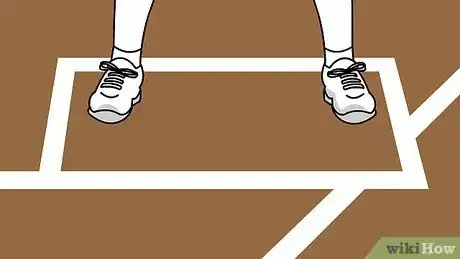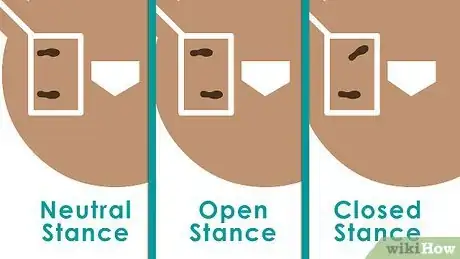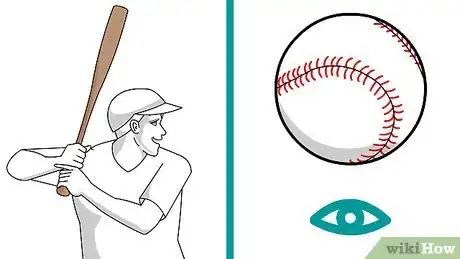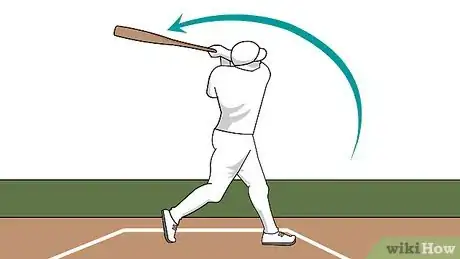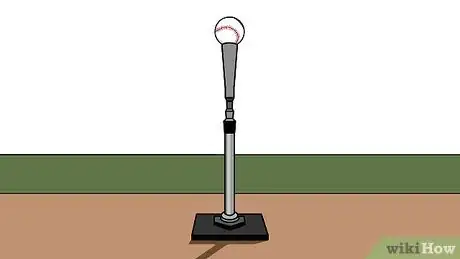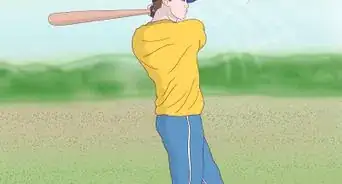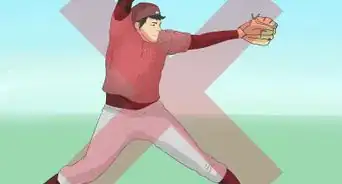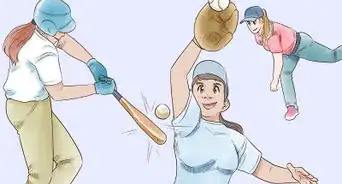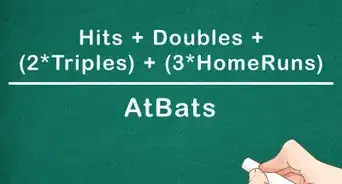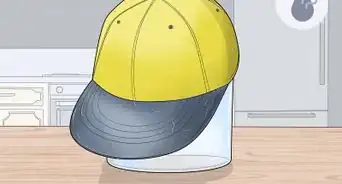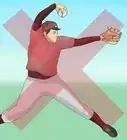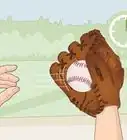This article was co-authored by Isaac Hess. Isaac Hess is a Baseball Coach, Instructor, and the Founder of MADE Baseball Development and Champion Mindset Training Program, a baseball training program based in Los Angeles, California. Isaac has over 14 years of experience coaching baseball and specializes in private lessons and tournaments. He has played baseball for both professional and collegiate leagues including Washington State University and the University of Arizona. Isaac was ranked as one of Baseball America's top 10 prospects for 2007 and 2008. He earned a BS in Regional Development from the University of Arizona in 2007.
There are 9 references cited in this article, which can be found at the bottom of the page.
This article has been viewed 298,673 times.
Hitting a baseball is one of the most challenging tasks in sports, even when it’s pitched in the same manner again and again by a batting machine. Even more challenging is when you have to face a live pitcher who might throw a curveball or a fastball or something else entirely. However, by practicing a few key concepts whenever you’re at bat, you can drastically improve your chances of connecting with the ball and delivering a powerful hit. Knowing these concepts isn’t enough, though. You need to practice until they become ingrained.
Things You Should Know
- Maintain eye contact with the ball from the moment it leaves the pitcher's hand to when you hit it.
- When you go to swing, raise your back heel, stand on your back toes, and shift your weight to your front leg.
- Use your whole body to swing. Swing your hips and follow through with your arms.
- Keep the bat parallel to the ground as you hit the ball.
Steps
Getting into Position
-
1Stand in the batter’s box. If you are right-handed, stand in the box on the left side of home plate when facing the pitcher, so that you are on the third-base side of home plate. If you are left-handed, opt for the right, on the first-base side.[1] Face home plate. Touch the far side of home plate with the end of your bat. Back up until your arm is fully extended.[2]
- Feel free to experiment with standing on each side of the box. Some right-handed hitters prefer standing on the right side of home plate, and vice versa with left-handed hitters.
- Don’t stand too close or too far from the plate. Standing too far away will make it much more difficult to hit outside pitches. Crowding the plate will do the same with inside pitches.
- If you are a beginner, start by standing directly across from the plate. After a lot of practice in this position, experiment with moving up toward the front of the box or further back, which may make it easier to hit certain pitches. Hitting from the rear of the box, for example, will provide extra time for you to hit a fastball.
-
2Determine which of your eyes is dominant. Place any object (a batting tee, a fellow player, etc.) roughly 20 feet away from you (6 meters). Stick your arm straight out in front of you. With both eyes open, raise your thumb into a thumbs-up so that it blocks the object from view. Shut one eye. If your view remains the same, open that eye and shut the other. Whichever eye is suddenly able to see the object is your dominant eye.[3]
- Right-handed people often have a dominant right eye. Left-handed people typically have a dominant left eye.
- Determining which eye is dominant will help you choose the best stance to adopt at the plate.
Advertisement -
3Choose your stance. Pick between the neutral, open, and closed stances. Base your decision partly on whichever one makes it easier to keep your dominant eye on the ball. Also consider how the placement of your feet in each position affects your swing.[4] In addition, you may need to adjust your stance based on whether the pitcher is throwing fast or slow.[5] Regardless of which one you choose, bend your knees a little. Point your toes toward the plate with your feet spread to shoulder-width or a few inches wider.[6] [7]
- Neutral stance (also called "even stance"): Both feet are placed an equal distance from home plate. This is the most popular stance, since it allows you to turn your head over your shoulder without any strain so you can face the pitcher and keep both eyes on the ball.
- Open stance: The foot closest to the pitcher is moved slightly back so that the front of your body is a little more “open” to the pitcher. This is the least popular stance because it takes you out of hitting position, thus creating extra steps to get back into position during the pitch.
- Closed stance: The foot closest to the pitcher is placed a tiny bit forward. This stance allows you to cover more of the plate with your bat. However, turning your head to keep both eyes on the pitcher may be more of a strain.
- If pointing your forward foot toward home plate proves to be uncomfortable, try adjusting it so that your toes point 45 degrees more toward the pitcher.
-
4Hold your bat correctly. Cradle the grip in the middle of your fingers instead of your palms. If you are right-handed, grip the bat with your left fingers an inch or two above the very bottom. Then place your right fingers above your left. Extend your arms in front of you as if you just took a swing. Make sure the palm of your left hand is facing downward and the palm of your right is facing up. If you are left-handed, do the reverse.
- Keep a secure grip on the bat, but also keep your grip loose enough so that your muscles are relaxed.[8]
- Adjust your grip so that the second knuckles of both hands form a perfect line.
-
5Raise the bat. Keep your shoulders in a straight line pointed toward the pitcher.[9] Bend both elbows. Draw your rear elbow up and back until it is level with your rear shoulder and pointing directly behind you. Keep both elbows roughly six to eight inches (15 to 20 cm) away from you. Angle the bat 45 degrees over your rear shoulder.[10]
- Resting the bat on your shoulder or holding it horizontally will weaken your swing.
- Holding the bat vertically can create a more powerful swing, but may be uncomfortable for beginners.
- Make sure you're using the right bat size. If you're using a bat that's too heavy, you won't be able to swing through the zone.[11]
Swinging
-
1Watch the ball. Turn your head toward the pitcher over your front shoulder. Keep your head still and straight, without cocking it to one side. Focus with both eyes on the ball from the moment it leaves the pitcher’s hand to the instant you make contact with the bat.
- Practice how to swing a baseball bat as much as you can before going to bat in a game. Train until the swing comes naturally, without you having to think about every little step. This way you are better equipped to concentrate on the ball with your full attention, instead of also having to plot out what to do next.
-
2Load and stride. Imagine that you are the hammer to a pistol aimed at the pitcher. Now imagine that you are being cocked to fire as the ball approaches. Move your body’s weight to your rear leg until your rear knee and shoulder are aligned (this is the “load”). Now raise your front foot and take a short step toward the pitcher (this is the “stride”).[12]
- Keep your stride short so that your body’s weight can shift more easily from your rear leg to your front leg once you begin to swing.
-
3Keep your front leg stable. Plant your front foot in place and keep it there throughout your swing. Bend your knee a little if keeping it straight proves to be uncomfortable. Use this leg to prevent yourself from spilling forward with the forward momentum created by your swing.
- Moving your front foot during your swing will cause you to swing a slower bat.
- Having an unstable front leg will also make it harder for you to keep your head still.
-
4Raise your back heel. As you begin your swing, stand on your back toes. Let the weight of your body shift to your front leg, in the ball’s direction, to add more power to your swing. Ensure that all of your swing’s momentum is aimed directly at the ball.
- The position of your feet should ultimately form a triangle, with your head as its point. The sides between your head and each foot should be relatively equal. This gives you near perfect balance.
-
5Swing with your hips. Use your whole body to swing the bat, not just your arms. As you begin your swing, lead with your rear hip and then follow through with your arms and hands.[13] Keep your elbows bent and tucked in as close to your sides as you can.
- Pivot on your back toes as you swing, so they end up pointing toward the pitcher.
- The closer you keep the bat to your body, the more power you can deliver with your swing.
-
6Hit the ball. As you bring your bat down from its starting position, aim to keep it parallel to the ground. At the same time, bring it level to the ball’s plane of trajectory. Time your movements so that you hit the ball at the precise moment when your rear hip and shoulder have swung forward to the point that your upper torso is now squarely facing the pitcher.[14]
- Aim to hit the ball with your bat’s “sweet spot,” roughly five to seven inches from the top of the bat.[15]
- Keeping the bat parallel to the ground and level with the ball will better ensure that you still hit the ball even if you miss it with the bat’s sweet spot.
-
7Swing through the ball. Aim to hit the ball when your swing is at its most powerful. Ensure this by swinging “through the ball” (also called “following through”). Instead of swinging the bat just far enough to make contact with the ball, wait until you have actually hit it before you quit adding force to your swing. Then let the bat slow down as it crosses in front your chest.
- Your swing should begin with your chin facing your front shoulder. Without moving your head, your chin should then face your rear shoulder by the end of your swing as you follow through.[16]
- Think of a sprinter crossing a finish line. They don’t slow down and come to a dead stop right at the finish line. They sprint at full speed straight through it. Only then do they slow down bit by bit until they finally stop well past the finish line.
Practicing
-
1Focus on balance first. Start by learning how to move fluidly from movement to movement while staying balanced throughout. Worry about hitting an actual ball later. For now, follow a four-count drill to learn how to move through your stance, load, stride, and swing effectively.[17] Start with a slow count to better identify mistakes. As you master each step, speed up the count so it becomes more natural and fluid.
- First, adopt your stance.
- On the count of “one,” load up.
- On “two,” take your stride forward.
- On “three,” train your eyes on the imaginary ball.
- On “four,” swing.
-
2Quicken your hips. Remember that your swing should be led by your rear hip, not your arms or hands. Hold the bat incorrectly during some of your four-count drills in order to force all of your concentration onto your hips. Instead of using both hands to hold it by its grip, hold the bottom of the bat in one hand and its top in the other.
- Instead of awkwardly drawing the bat up to shoulder-level, draw it behind your rear hip during your stance, load, and stride.
-
3Use a batting tee. Before accepting pitches, train with a stationary tee. Learn how to hit a ball with maximum power before worrying about connecting with a ball in motion. Use this time to perfect your movements, as well as following through.[18]
- Place the tee at different points across the plate to grow accustomed to hitting different pitches.
-
4Train with lighter balls. Once you are confident in your form, start hitting live balls. But instead of moving on directly to baseballs, start off with a ball that is less heavy. Try tennis balls, whiffle balls, or practice baseballs, since these travel at slower speeds due to their lightness.[19] Train your eyes to follow these slower balls, which are easier to track.
- From there, advance to actual baseballs, either thrown by a live pitcher or a pitching machine.
Community Q&A
-
QuestionShould I bring down my elbow?
 DonaganTop AnswererDo what's comfortable while taking your stance. If you drop your elbow while awaiting a pitch, you will raise it automatically as you begin your swing.
DonaganTop AnswererDo what's comfortable while taking your stance. If you drop your elbow while awaiting a pitch, you will raise it automatically as you begin your swing. -
QuestionIf the bat is flung, will it always result in an out?
 DonaganTop AnswererNo, but an umpire may decide that the bat was thrown too far and call the batter out (or simply give the player a warning).
DonaganTop AnswererNo, but an umpire may decide that the bat was thrown too far and call the batter out (or simply give the player a warning). -
QuestionShould I drop my back shoulder when swinging?
 Community AnswerNo, because if you drop your back shoulder your hit will very likely result in a pop up or fly ball.
Community AnswerNo, because if you drop your back shoulder your hit will very likely result in a pop up or fly ball.
Warnings
- Always wear protective gear (especially a helmet).⧼thumbs_response⧽
References
- ↑ http://www.baseball-reference.com/bullpen/Batter
- ↑ http://www.stack.com/a/hitting-fundamentals
- ↑ http://www.beabetterhitter.com/the-three-batting-stances-and-vision/
- ↑ http://www.beabetterhitter.com/the-three-batting-stances-and-vision/
- ↑ Isaac Hess. Baseball Coach & Instructor. Expert Interview. 20 March 2020.
- ↑ http://protips.dickssportinggoods.com/improve/teaching-your-child-to-swing-a-baseball-bat/
- ↑ http://www.baseballmonkey.com/article-proper-batting-stance
- ↑ http://www.beabetterhitter.com/the-grip-it-starts-with-the-hands/
- ↑ http://protips.dickssportinggoods.com/improve/teaching-your-child-to-swing-a-baseball-bat/
- ↑ http://www.baseballmonkey.com/article-proper-batting-stance
- ↑ Isaac Hess. Baseball Coach & Instructor. Expert Interview. 20 March 2020.
- ↑ http://www.stack.com/a/hitting-fundamentals
- ↑ http://protips.dickssportinggoods.com/improve/teaching-your-child-to-swing-a-baseball-bat/
- ↑ http://protips.dickssportinggoods.com/improve/teaching-your-child-to-swing-a-baseball-bat/
- ↑ http://www.acs.psu.edu/drussell/bats/sweetspot.html
- ↑ http://www.stack.com/a/hitting-fundamentals
- ↑ http://www.stack.com/a/hitting-fundamentals
- ↑ http://www.stack.com/a/hitting-fundamentals
- ↑ http://protips.dickssportinggoods.com/improve/teaching-your-child-to-swing-a-baseball-bat/
- Videos provided by ProSwingNY
About This Article
To hit a baseball, stand in the batter’s box with your knees slightly bent and your toes pointed toward the plate. Hold the bat so it’s angled about 45° over your rear shoulder. When the pitcher throws, keep your eyes on the ball, shift your weight to your back leg, then take a short step toward the pitcher and swing the bat, using your hips and your shoulders to rotate as you do so. Keep the bat parallel to the ground and swing it so it meets the trajectory of the ball. Read on to learn how to properly grip a baseball bat!
